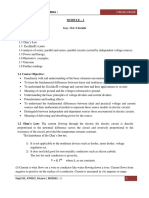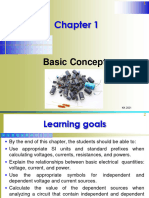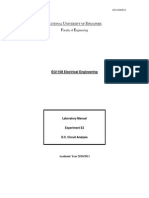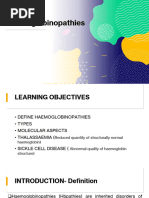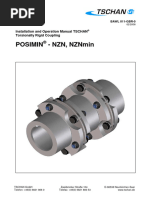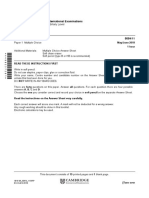Basic Bioinstrumentation Systems
Basic Bioinstrumentation Systems
Uploaded by
glorynjoku20Copyright:
Available Formats
Basic Bioinstrumentation Systems
Basic Bioinstrumentation Systems
Uploaded by
glorynjoku20Original Title
Copyright
Available Formats
Share this document
Did you find this document useful?
Is this content inappropriate?
Copyright:
Available Formats
Basic Bioinstrumentation Systems
Basic Bioinstrumentation Systems
Uploaded by
glorynjoku20Copyright:
Available Formats
CONCEPTS 1
BASIC BIOINSTRUMENTATION SYSTEMS
CONCEPTS
MESAURAND is the quantity/property/condition measured by any instrumentation
system. It may be:
Bioelectrical (e.g. generated by muscles and CNS)
Chemical or
Mechanical
Which can be converted to electrical signal.
SENSORS are generally able to convert physical measurands into electrical outputs.
These outputs are usually analogue which must be processed (converted) to digital
signals, and also amplified, filtered, conditioned and converted to a digitally readable form
(output0
OUTPUT display devices are either visual or audio formats and may display numerical,
graphical, discrete, continuous, permanent or temporary signals. The signals (data) may
need to be stored or transmitted in/to another device or from one place to another e.g. from
patient to hospital to enable diagnostic feedback.
A CALIBRATION SIGNAL (of known amplitude and frequency) is usually applied to the
sensor unit. This allows the components of the bioinstrumentation system to be adjusted
so that the output and input have a known measured relationship.
FEEDBACK ELEMENT may be included in some systems. They function to collect data
from the measured signals and stimulate a response when needed (bio-feedback system).
Figure 1. Basic aspects of a basic instrumentation system
MLS 402 BASIC BIOINSTRUMENTATION SYSTEMS OKEY ONWUKWE
ELECTRICAL PRINCIPLES AND CONCEPTS 2
ELECTRICAL PRINCIPLES AND CONCEPTS
All bioinstrumentation systems rely on electrical circuits to work. The following terms are
useful for describing circuits.
Figure 2. Simple electric circuit
NODE: the point at which two or more circuit elements have a common connection.
BRANCH: A circuit element or a connected group of elements; usually connects nodes
together.
PATH: a connected group of circuit elements in which no element is repeated.
CLOSED PATH: a path that starts and ends with one node.
MESH: a closed path without any other closed path within itself.
ESSENTIAL NODE: a common point of connection between three or more circuit
elements.
ESSENTIAL BRANCH: a branch connecting two essential nodes.
MLS 402 BASIC BIOINSTRUMENTATION SYSTEMS OKEY ONWUKWE
ELECTRICAL PRINCIPLES AND CONCEPTS 3
ELECTRICAL PRINCIPLES
A. CHARGE. May be positive or negative (carried by protons and electrons respectively).
It is measured in Coulombs (C) and defined as the smallest charge qe carried by an
electron. qe = -1.602 x 10-19. A proton carried the exact opposite of the charge of an
electron.
B. CURRENT: i(t) is defined as the change in amount of charge that passed through a
given point or area in a specified time period. It is measured in Amperes (A) which is
defined as equal to one Coulomb/second (C/s). Current depends on direction of flow. It
is positive if a positive charge is moving in the direction of the arrow (fig 3) or negative
if it is moving in the opposite direction.
Figure 3: Node with 4 currents.
Kirchhoff’s Current Law – current can only flow in a closed circuit. No current is lost as
it flows around the circuit because net charge cannot accumulate within the circuit
element and charge must be conserved. Current entering one terminal must leave the
other terminal. Since charge cannot be created and must be conserved, sum of currents at
any node must be equal to zero so that no net charge accumulates.
Mathematically, Kirchhoff’s law is represented as –
∑ in (t) = 0 and this applies to all current whether entering or leaving a node.
So from fig 3 above, -i1 – i2 = i4 = i3 = 0.
C. VOLTAGE: this represents the work per unit charge associated with moving a charge
between point A and B.
It is given as v = dw/dq.
Voltage is measured in volt (V) constant DC voltage is denoted by V while time-varying
voltage is denoted by v(t) or just v. Hence voltage between two points is the amount of
energy required to move a charge from point A to B.
Kirchhoff’s voltage law – sum of all voltages in a closed path is zero.
Mathematically, ∑ vn (t) = 0
Generally, Kirchhoff’s laws are applied in electric circuit analysis to determine unknown
voltages and currents.
D. POWER AND ENERGY: Power is the rate of energy expenditure given as
P = dw/dt = dw/dt * dq/dt = VI (recall that energy in electricity is also refers to voltage).
Power is measured in watts while Energy is measured in joules (J).
MLS 402 BASIC BIOINSTRUMENTATION SYSTEMS OKEY ONWUKWE
ELECTRICAL PRINCIPLES AND CONCEPTS 4
Hence, P = V * I.
A positive value for P indicates that power is being delivered to a circuit element while a
negative value indicates that power is extracted from or generated by the circuit element
e.g. a battery.
There are 4 possible current-voltage configuration for any given circuit as shown below:
If i and v are positive (as shown by the arrow and polarity), the energy is
absorbed (either lost or conserved).
If either the current arrow and voltage polarity is reversed (B and C), energy
is supplied to the circuit.
If both current direction and voltage polarity are reversed together (D), energy
is absorbed.
Figure 4: Polarity references for four cases of current and voltage. Cases A and D result
in positive power being consumed by the circuit element. Cases B and C result in negative
power being extracted from the circuit element
Passive circuit element is one whose power is always positive or zero, which may be
dispelled as heat (resistance), stored in an electric field (capacitor) or stored in a magnetic
field (inductor).
Active circuit element is one whose power is negative and capable of generating energy.
E. SOURCES. There are two terminal devices that provide energy to a circuit. An ideal
voltage source is one that generates a prescribed voltage at its terminal regardless of
the current flow. In the same way, an ideal current source provides the prescribed
current to the attached circuit. Ideal current and voltage sources are known as
independent sources.
Dependent voltage and current sources take on values equalling a known function of some
other voltage or current value in the circuit.
Dependent sources are important in electronics since they allow for operational
amplification (e.g. when using a controlled voltage source).
MLS 402 BASIC BIOINSTRUMENTATION SYSTEMS OKEY ONWUKWE
ELECTRICAL PRINCIPLES AND CONCEPTS 5
Figure 5: symbols for independent sources
Figure 6: symbols for dependent/controlled sources
RESISTANCE
A resistor is a circuit element that limits the flow of current through it. It is denoted by
ꟿ (Figure 7).
Different materials are used for resistors and their ability to impede current is given with
a value of resistance R which is measured in ohms (ꭥ).
Figure 7: an ideal resistor
1ꭥ = 1V/A
Theoretically a bare wire connected to a circuit has zero resistance and a gap between
circuit elements has a resistance of infinity.
Ideal resistors obey Ohms law which describes a linear relationship between voltage and
current, with the slope equal to the resistance
V = iR or V = -iR
Ohms law does not apply at very high voltages and currents. With physiological models,
it is easier to apply the law because linearity is observed at certain range of values.
In short circuits, R = 0 ꭥ, V = 0 while in open circuits, R = α (infinity) with 0A of current
flowing through.
MLS 402 BASIC BIOINSTRUMENTATION SYSTEMS OKEY ONWUKWE
ELECTRICAL PRINCIPLES AND CONCEPTS 6
Figure 8: resistance in short and open circuits
For every material, the Resistivity (ρ) indicates its resistance. Conductivity (σ) is the
inverse of resistivity and conductance (G) is the inverse of resistance measured in siemens
(S).
Equivalent Resistance: this is the resistance of two or more identical circuits (in terms of
voltage and current measurements). This applies when complex circuits have been
simplified.
Resistors in series: here the same current flows from one resistor to another i.e. the same
current flows through n number of resistors.
Req = R1 + R2 + R3 …. + Rn
Figure 9: Series circuit
Resistors in parallel: two or more resistors are said to be in parallel if the same voltage is
across each of the resistors.
They are denoted by “II” e.g. Req = R1 II R2 II R3 …. II Rn
Req =1/ [1/R1 + 1/R2 + 1/R3 …. +1/Rn]
For 2 resistors in parallel, Req = R1 II R2 = R1R2/R1 + R2
Figure 10: Parallel circuit
MLS 402 BASIC BIOINSTRUMENTATION SYSTEMS OKEY ONWUKWE
ELECTRICAL PRINCIPLES AND CONCEPTS 7
Voltage and Current Divider Rules
These concepts allow for the calculation of voltages in series resistor circuits and currents
in parallel resistor circuits.
Voltage Divider Rule: in the diagram below, applying this rule enables the easy
calculation of voltage across the resistors.
To find V2 where REQ = R1 + R2.
Therefore: I = Vs/REQ = Vs/R1 + R2 and V2 = IR2 = Vs(R2/R1 + R2)
Same applies for V1 as V1 = VS (R1/R1 + R2)
For N number of resistors in series, the voltage divider rule gives the voltage across any
one of the resistors, Ri, as
Vi = VS (Ri/R1 + R2 + … RN)
Fig 11: Voltage divider rule circuit
Current Divider Rule: this allows for easy calculation of current through any resistor in
parallel resistor circuits. In the diagram below, to calculate I2, where REQ = R1R2/(R1 + R2)
I2 = VS/R2
Fig 12: Current divider rule circuit
VS = I (R1R2/[R1 + R2]
After substituting VS
MLS 402 BASIC BIOINSTRUMENTATION SYSTEMS OKEY ONWUKWE
ELECTRICAL PRINCIPLES AND CONCEPTS 8
For N number of resistors in parallel, the current divider rule gives the current through
one of the resistors, Ri, as
INDUCTORS
An inductor is a passive element that is able to store energy in a magnetic field and is
made by winding a coil of wire around an insulating or ferromagnetic core. A magnetic
field is created when current flows through the coil. The unit of measure for inductance is
the henry or henries (H) where 1H = 1V – s/A.
For an inductor, the relationship between current and voltage is given by:
v = L* di/dt
Where L is the inductance in henries (H), v is the instantaneous voltage and di/dt is the
rate of change of current.
An inductor.
Inductors are used AC powered electronic devices to allow DC and AC to pass through to
downstream components. They are also used for separating signals according to
frequencies (as electronic filters).
CAPACITORS
A capacitor is a device that stores energy in an electric field by charge separation when
appropriately polarised by voltage. A capacitor is made of parallel plates of conducting
materials separated by a gap filled with dielectric material (e.g. air, mica, Teflon – these
materials usually have high resistance). Dielectric materials contain large number of
electric dipoles which become polarised when electricity is passed.
The charge separation caused by polarisation of the dielectric is proportional to the
external voltage passed.
Figure 13: A simple capacitor
The formula q(t) = Cv(t) is used to represent the relationship between charge and voltage
in capacitors where C is the capacitance measured in farads (F). 1 F = I*C/V. Most
capacitors are measured in micro farads and pico farads.
MLS 402 BASIC BIOINSTRUMENTATION SYSTEMS OKEY ONWUKWE
BIOINSTRUMENTATION DESIGN 9
The symbol for a capacitor.
Figure 14: Circuit with a capacitor
Capacitors are used as temporary charge stores. They find application in time dependent
circuits where charging and discharging is needed. They are also used to smooth out AC
currents into DC by discharging at the peak of the AC cycle. They can block DC and allow
AC in some configurations and can be used for tuning frequencies.
BIOINSTRUMENTATION DESIGN
The elements described above (and indeed many more complex ones) are needed in a
biomedical instrumentation system. The main idea behind these kinds of instruments is
the ability to monitor the output of a sensor(s) and to extract relevant information from
signals produced by the sensors.
Analog-to-digital converters enables the acquisition of a discrete-time signal from a
continuous-time signal. The A/D converter uniformly samples the continuous-time wave
form and transforms it into a sequence of numbers, one for every tk seconds. The A/D
converter essentially transforms the continuous-time waveform into a digital signal which
is in turn converted into words stored in a computer memory.
Noise
Interference noise occurs when unwanted signals introduced to the system by outside
sources e.g. power lines, radio and TV EM waves. Filters are used to reduce the noise and
to maximise the signal-to-noise (S/N) ratio at the A/D converter input. Low frequency
noise (e.g. amplifier DC offsets, sensor drifts, temp fluctuations etc.) can be eliminated by
a high pass filter with the cut off frequency set above the noise frequencies and below the
biological signal frequencies.
Inherent noise arise from random processes fundamental to the operating circuit and this
can easily be reduced by good circuit design practice. Inherent noise can only be reduced
but not eliminated. Low pass filters can be used to reduce high frequency components.
This will not work if the frequency of the biosignal is within the range of the noise signals.
Signal processing
The objective of signal processing is to remove the effects of noise and enhance signal
quality. Filters are mathematical functions which are applied to the signals (post
acquisition) contained within the spectra. These mathematical functions can be simple or
very complex. Examples include moving average, Savitzky-Golay functions for smoothing
signals, derivatives, Fourier transform, Kalman filter, wavelets, maximum entropy.
MLS 402 BASIC BIOINSTRUMENTATION SYSTEMS OKEY ONWUKWE
BIOINSTRUMENTATION DESIGN 10
Computers in bioinstrumentation systems
Three basic units make up the computer – the central processing unit (CPU), the
arithmetic and logic unit (ALU), and memory.
CPU directs the function of all other units and controls the flow of information among the
units. This CPU is controlled by program instructions.
The ALU performs arithmetic calculations (+, -, x, /) and logical operations (AND, OR,
NOT) that compare sets of information.
Computer memory consists of ROM (permanently programmed into the IC that forms the
basis of the CPU and cannot be changed) and RAM (which stores information temporarily
and can be changed by the user; user generated programs, input data and processed data
are stored here).
Computers are binary devices – the presence of electrical signal denotes 1 while the
absence denotes 0. Signals are combined in groups of 8 bit, a byte, to code information.
Programming languages relate instructions and data to a fixed array of binary bits so that
specific arrangements has only one meaning. Letters of the alphabet and other symbols
(e.g., punctuation marks) are represented by special codes. ASCII stands for the American
Standard Code for Information Exchange. ASCII provides a common standard that allows
different types of computers to exchange information
The lowest level of computer languages is machine language, which consists of the 0s and
1s that the computer interprets. Machine language represents the natural language of a
particular computer.
Assembly languages is the next level and use English-like abbreviations for binary
equivalents. Programs written in assembly language can manipulate memory locations
directly. These programs run very quickly and are often used in data acquisition systems
that must rapidly acquire a large number of samples, perhaps from an array of sensors,
at a very high sampling rate.
Higher-level languages (e.g. FORTRAN, PERL, and C++) contain statements that
accomplish tasks that require many machine or assembly language statements.
Instructions in these languages often resemble English and contain commonly used
mathematical notations. They are easier to learn.
Programs instruct the computers on when and how to use various hardware components
to solve specific problems. These instructions must be delivered to the CPU in the correct
sequence. In acquiring physiological data for instance, programming instructions tell the
computer when data acquisition should begin, how often samples should be taken from
how many sensors, how long data acquisition should continue, and where the digitized
data should be stored. The speed of the computers clock (in Hz) and the number of
instructions per sampling step determine the rate of sampling by a system.
MLS 402 BASIC BIOINSTRUMENTATION SYSTEMS OKEY ONWUKWE
You might also like
- Application Note Matlab Calls CSTDocument6 pagesApplication Note Matlab Calls CSTsmriti127100% (4)
- Essilor 2015 Range GuideDocument226 pagesEssilor 2015 Range GuideharidwNo ratings yet
- Files 2-Chapters Chapter 6 Electrical and Electromechanical Systems 2Document19 pagesFiles 2-Chapters Chapter 6 Electrical and Electromechanical Systems 2Naveen KrishnaNo ratings yet
- Ee303 1Document10 pagesEe303 1api-288751705No ratings yet
- Chapter 2 DC Circuit TheoryDocument37 pagesChapter 2 DC Circuit TheoryTynoh MusukuNo ratings yet
- Chapter 2: DC Circuit TheoryDocument37 pagesChapter 2: DC Circuit TheoryTaonga Nhambi100% (1)
- EC-IIDocument17 pagesEC-IIAnikendu MaitraNo ratings yet
- 2-Chapters Chapter 6 Electrical and Electromechanical Systems 2Document21 pages2-Chapters Chapter 6 Electrical and Electromechanical Systems 2Krushnasamy SuramaniyanNo ratings yet
- Electrical Components and Circuits Not MineDocument21 pagesElectrical Components and Circuits Not MineMark Cliffton BadlonNo ratings yet
- Electronics Engineering Notes Unit 1st YearDocument11 pagesElectronics Engineering Notes Unit 1st Yearmahvs.1311No ratings yet
- Basic Writing Skill TxtbookDocument16 pagesBasic Writing Skill Txtbookyacob sozoNo ratings yet
- Chapter02Document26 pagesChapter02ahmedamer0aa0No ratings yet
- Theories of Electric Circuit AnalysisDocument11 pagesTheories of Electric Circuit AnalysisKhaled IbrahimNo ratings yet
- Ch-2 Electrical Circuit Anlysis-PART 1Document44 pagesCh-2 Electrical Circuit Anlysis-PART 1temesgen adugnaNo ratings yet
- Chapter 1Document20 pagesChapter 1cherkos weldayNo ratings yet
- BEEE - Part a - Unit I - DC & AC CircuitsDocument46 pagesBEEE - Part a - Unit I - DC & AC Circuitsthrishareddy112No ratings yet
- E109 - AgustinDocument25 pagesE109 - AgustinSeth Jarl G. AgustinNo ratings yet
- Network Analysis Chap.1 KVL & KCL - pdf-1Document34 pagesNetwork Analysis Chap.1 KVL & KCL - pdf-1thanu100% (2)
- Module1 1Document46 pagesModule1 1Disha GoyalNo ratings yet
- Topics To Be Covered: Unit-2: Basic Circuit ElementsDocument11 pagesTopics To Be Covered: Unit-2: Basic Circuit ElementsParthaNo ratings yet
- Module 1 - BEE - DC Circuits & Electromagnetic InductionDocument21 pagesModule 1 - BEE - DC Circuits & Electromagnetic InductionSanjay SNo ratings yet
- 04 Basic Electrical, Electronics and Measurement EngineeringDocument82 pages04 Basic Electrical, Electronics and Measurement EngineeringkrishnandrkNo ratings yet
- Chapter 1 Basic ElectricityDocument26 pagesChapter 1 Basic ElectricityBirhex FeyeNo ratings yet
- RLC Series-Parallel Circuit AnalysisDocument2 pagesRLC Series-Parallel Circuit AnalysisShah Zeb Yousafzai100% (1)
- BEEE Quick NotesDocument83 pagesBEEE Quick Notespriyazoe54No ratings yet
- EIS Nota AC-1 EG&GDocument13 pagesEIS Nota AC-1 EG&GHarry MarshallNo ratings yet
- Network Analysis: by Mrs - Eranki Laita Mrs Jyoti MaheshwariDocument47 pagesNetwork Analysis: by Mrs - Eranki Laita Mrs Jyoti Maheshwarilalitaeranki100% (1)
- BEEM 2marks PDFDocument40 pagesBEEM 2marks PDFPragna Sidhireddy100% (1)
- UNIT 1 (3)Document46 pagesUNIT 1 (3)Risika SinghNo ratings yet
- Chapter 2Document17 pagesChapter 2ahmedherohero9No ratings yet
- BEE - EEE - B22EE0101 - Unit 1 - NotesDocument46 pagesBEE - EEE - B22EE0101 - Unit 1 - NotesKhaushik KumaarNo ratings yet
- DC and Ac NetworksDocument12 pagesDC and Ac NetworksEzekiel JamesNo ratings yet
- Module 1 DC Circuits (Part - 2)Document14 pagesModule 1 DC Circuits (Part - 2)Sattwik MannaNo ratings yet
- ABC of Battery TestingDocument18 pagesABC of Battery TestingAbid HussainNo ratings yet
- Unit I - NotesDocument42 pagesUnit I - NotesPrashant DandadeNo ratings yet
- Circuit Lab Report 2Document8 pagesCircuit Lab Report 2aeshahalmutairi4No ratings yet
- WWW Universityquestions inDocument63 pagesWWW Universityquestions inRajgir Raj100% (1)
- GEL104 DC CircuitsDocument25 pagesGEL104 DC CircuitsBhupender Singh ChughNo ratings yet
- Unit 2Document11 pagesUnit 2abhimanyukr00003No ratings yet
- 2 Ohm's Law: ExperimentDocument25 pages2 Ohm's Law: ExperimentAkshay PabbathiNo ratings yet
- BEEE NotesDocument8 pagesBEEE NotesSrinathReddyNo ratings yet
- الدوائر الكهربائية من 1 لغاية 8 1Document60 pagesالدوائر الكهربائية من 1 لغاية 8 1abbas00170No ratings yet
- Basics of Power SystemsDocument63 pagesBasics of Power SystemsAravind BalaNo ratings yet
- BE3251-BASIC ELECTRICAL AND ELECTRONICS ENGINEERING-985171954-BE 3251 BEEE NotesDocument64 pagesBE3251-BASIC ELECTRICAL AND ELECTRONICS ENGINEERING-985171954-BE 3251 BEEE NotesJemima ANo ratings yet
- General Physics 2: Grade 12Document53 pagesGeneral Physics 2: Grade 12Del Mundo, Jelo ArsuaNo ratings yet
- DC Network - 6 - 26 - 18Document61 pagesDC Network - 6 - 26 - 18Neli Aguilar SenupeNo ratings yet
- Eee Chapter-2Document4 pagesEee Chapter-2JANAPANA TIRUMALA RAONo ratings yet
- Current ElectricityDocument10 pagesCurrent ElectricityClemence TafitiNo ratings yet
- ETE 1112 - Basic Electrical Engineering Lab ManualDocument27 pagesETE 1112 - Basic Electrical Engineering Lab ManualSabuj Ahmed100% (1)
- Chapter 1 - Basic Concepts in Electrical TechnologyDocument31 pagesChapter 1 - Basic Concepts in Electrical TechnologyDouglas OngomNo ratings yet
- Basic Electrical LabDocument32 pagesBasic Electrical Labsrinu247No ratings yet
- Unit 1 - Network Analysis - WWW - Rgpvnotes.inDocument17 pagesUnit 1 - Network Analysis - WWW - Rgpvnotes.inmishranitesh25072004No ratings yet
- Circuit Chapter One and TwoDocument44 pagesCircuit Chapter One and Twokalkidaneb21No ratings yet
- Chapter 1Document48 pagesChapter 1bekeledamtew6No ratings yet
- 0.circuit VariableDocument17 pages0.circuit Variablemehmet kayacanNo ratings yet
- Basic Electronics Terms and DefinitionsDocument7 pagesBasic Electronics Terms and Definitionspondu888No ratings yet
- Basic Electrical Engineering - Leacture NotesDocument29 pagesBasic Electrical Engineering - Leacture NotesEngineer Zeeshan RasheedNo ratings yet
- Electrical Elements of Lift Technology Ed 3Document51 pagesElectrical Elements of Lift Technology Ed 3Fiorella Amer CarrNo ratings yet
- CB Lab Manual Cicrcuit LawsDocument13 pagesCB Lab Manual Cicrcuit LawsLin RongrongNo ratings yet
- Hypersensitivity ReactionDocument11 pagesHypersensitivity Reactionglorynjoku20No ratings yet
- VaccinationDocument25 pagesVaccinationglorynjoku20No ratings yet
- Femoral and Obturator NerveDocument41 pagesFemoral and Obturator Nerveglorynjoku20No ratings yet
- Rectum and Anal CanalDocument31 pagesRectum and Anal Canalglorynjoku20No ratings yet
- HaemoglobinopathiesDocument45 pagesHaemoglobinopathiesglorynjoku20No ratings yet
- Instrukcja Tschan Posimin NZN NZN MinDocument17 pagesInstrukcja Tschan Posimin NZN NZN MinAkshay SetlurNo ratings yet
- Understanding Caking Phenomena in Industrial Fertilizers: A ReviewDocument14 pagesUnderstanding Caking Phenomena in Industrial Fertilizers: A ReviewAlexandros GiannikosNo ratings yet
- E5174 RbeDocument4 pagesE5174 RbeVinod YbNo ratings yet
- Corey E.G., Chelg X. The Logic of Chemical Synthesis (Wiley, SDocument462 pagesCorey E.G., Chelg X. The Logic of Chemical Synthesis (Wiley, SHarrison VanKoten100% (1)
- CH 14 Hull OFOD9 TH EditionDocument31 pagesCH 14 Hull OFOD9 TH Editionseanwu95No ratings yet
- 5054 s18 QP 11 PDFDocument20 pages5054 s18 QP 11 PDFBreezy BrownNo ratings yet
- Food Safety SeminarDocument60 pagesFood Safety SeminarYuli ResmayantiNo ratings yet
- Math Worksheet Grade 1 RevisiDocument3 pagesMath Worksheet Grade 1 Revisianisasimamora19No ratings yet
- Integer SolutionDocument2 pagesInteger SolutionDrkhan JdpNo ratings yet
- Budget of Work in Mathematics 9Document3 pagesBudget of Work in Mathematics 9reysheila.boholNo ratings yet
- CH3 - Stiffness Method - Beams FramesDocument58 pagesCH3 - Stiffness Method - Beams Frames2499361939wNo ratings yet
- What Is Voltage Stabilizer & How It Works? Types of StabilizersDocument15 pagesWhat Is Voltage Stabilizer & How It Works? Types of StabilizersCHakornNo ratings yet
- Defects in TMT Bars, Possible Causes and Potential Solutions.Document14 pagesDefects in TMT Bars, Possible Causes and Potential Solutions.Prashant Goswami100% (1)
- Untitled ScenarioDocument6 pagesUntitled ScenarioOmer JavidNo ratings yet
- Manual Honeywell 3200Document101 pagesManual Honeywell 3200transfat transnovagNo ratings yet
- OH WWWDocument46 pagesOH WWWEduardCraciunNo ratings yet
- 4_5866132153250614247Document5 pages4_5866132153250614247aabaky35No ratings yet
- CE 16 Timber Midterm 2020Document3 pagesCE 16 Timber Midterm 2020Angelo VilleroNo ratings yet
- Grade 10: Physics Chapter 2: SoundDocument3 pagesGrade 10: Physics Chapter 2: SoundKashif AliiiNo ratings yet
- CO2 Type Fire Extinguisher Technical Data SheetDocument2 pagesCO2 Type Fire Extinguisher Technical Data SheetSonu KrishnaNo ratings yet
- Lubrication System: Service DataDocument11 pagesLubrication System: Service DataEko SunaryoNo ratings yet
- Ground-Fault Monitoring - The Concept - BenderDocument6 pagesGround-Fault Monitoring - The Concept - BenderSathish KumarNo ratings yet
- Python Question BankDocument2 pagesPython Question BankShreyas Adki100% (1)
- Make and Program Your Own Robots For The Commodore 64 and VIC 20Document50 pagesMake and Program Your Own Robots For The Commodore 64 and VIC 20turboc201No ratings yet
- DLL - Mathematics 5 Q1 W8Document9 pagesDLL - Mathematics 5 Q1 W8Yvonne Sujede FloritaNo ratings yet
- Computer ICT AwarenessDocument340 pagesComputer ICT Awarenessjoginder kumarNo ratings yet
- Huawei RRU RRU3268 Installation Guide PDFDocument131 pagesHuawei RRU RRU3268 Installation Guide PDFgazouliNo ratings yet
- Learning A Structured Latent Space For Unsupervised Point Cloud CompletionDocument11 pagesLearning A Structured Latent Space For Unsupervised Point Cloud CompletionTimemachine611 “Timemachine611”No ratings yet




















